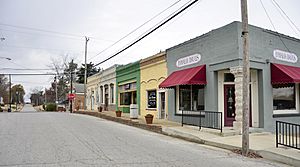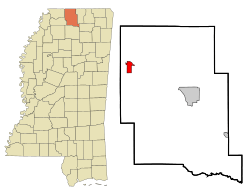Byhalia, Mississippi facts for kids
Quick facts for kids
Byhalia, Mississippi
|
|||
|---|---|---|---|

The Byhalia Historic District along Church Street is listed on the National Register of Historic Places.
|
|||
|
|||

Location in Marshall County and the state of Mississippi
|
|||
| Country | United States | ||
| State | Mississippi | ||
| County | Marshall | ||
| Area | |||
| • Total | 7.13 sq mi (18.5 km2) | ||
| • Land | 7.11 sq mi (18.4 km2) | ||
| • Water | 0.02 sq mi (0.05 km2) | ||
| Elevation | 381 ft (116 m) | ||
| Population | |||
| • Total | 1,339 | ||
| • Density | 188.43/sq mi (72.75/km2) | ||
| Time zone | UTC-6 (Central (CST)) | ||
| • Summer (DST) | UTC-5 (CDT) | ||
| ZIP code |
38611
|
||
| Area code(s) | 662 | ||
| FIPS code | 28-10060 | ||
| GNIS feature ID | 2405352 | ||
Byhalia (pronounced bye-HAIL-yuh) is a small town in Marshall County, Mississippi, United States. It is located in the northern part of the state. In 2020, about 1,339 people lived there. Byhalia is known for its historic district, which is listed on the National Register of Historic Places.
Contents
History of Byhalia
Byhalia was founded in the 1830s. It got its name from Byhalia Creek, a stream that flows near the community. The town officially became a town in 1873. It is located along the BNSF Railway, which is a major train route.
For a time, Byhalia had its own newspaper. It was called The Byhalia Journal. This newspaper was published from 1883 to 1899. A man named Sam Mims Jr. was the editor. He later became a member of the Mississippi Senate.
Geography and Location
Byhalia is in the northwestern part of Marshall County. Two major highways pass through or near the town. Interstate 22 goes through the southern part of Byhalia. You can get to it from Exit 14, which is MS 309.
Another highway, Interstate 269, also passes through the town's northwest side. This road is a beltway around Memphis, Tennessee. You can access it from Exit 18, also MS 309. From Byhalia, it's about 16 miles southeast to Holly Springs, which is the county seat. Downtown Memphis is about 30 miles northwest.
The town of Byhalia covers about 7.1 square miles. Most of this area is land. A small part, about 0.02 square miles, is water. Byhalia Creek flows through the eastern side of the town. This creek eventually joins the Coldwater River. The Coldwater River is part of the Tallahatchie River system.
Population and People
The population of Byhalia has changed over the years. In 1880, there were 346 people. By 2020, the population grew to 1,339 people.
Who Lives in Byhalia?
According to the 2020 United States Census, Byhalia had 1,440 people. There were 680 households in the town. About 470 families lived there.
In 2020, the population was made up of different groups:
- About 46.6% of the people were White.
- About 44.44% were Black or African American.
- A smaller number of people were Native American or Pacific Islander.
- About 2.39% were from other races or mixed races.
- About 5.9% of the people were Hispanic or Latino.
In 2010, the population was 1,302 people. At that time, about 51.4% were White and 44.9% were Black or African American. About 4.0% of the people were Hispanic or Latino.
Education
Students in Byhalia attend schools in the Marshall County School District. This school district is supported by the Mississippi Teacher Corps program.
Notable People from Byhalia
Many interesting people have connections to Byhalia:
- The Aces – A famous Chicago blues band.
- Erica Bougard – An Olympian who competes in track and field.
- Jan Bradley – A talented soul singer.
- Mike Bryan – A skilled jazz guitarist.
- William Faulkner – A very famous author who passed away in Byhalia in 1962.
- Bill Kinkade – A former member of the Mississippi House of Representatives.
- Willie Taylor – A former player in the NBA (National Basketball Association).
- Tommy Woods – Served in the Mississippi House of Representatives for many years.
- H. Casey Young – A former member of the United States House of Representatives.
See also
 In Spanish: Byhalia para niños
In Spanish: Byhalia para niños




